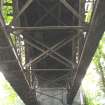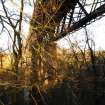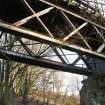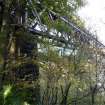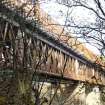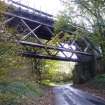Notice
Following a review of the Buildings at Risk Register we have paused the Register while we consider options for its future.
The website will remain accessible and searchable during this time, but it will not be updated and we’re not accepting nominations for additions to the Register. If you need to contact us about the BARR please email hmenquiries@hes.scot
Read the review report here and you can find out more about why we have paused the BARR on our news centre.
Larkhall Railway Viaduct, Over Avon Water
Ordnance Survey licence number AC0000807262. All rights reserved. © Copyright and database right 2025. Public Sector Viewing Terms
Useful Links
- Canmore:
- LARKHALL, MILLHEUGH, LARKHALL VIADUCT
- Historic Scotland:
- HS Reference No 5168
General Details and Location
Category
AT RISK
Name of Building
Larkhall Railway Viaduct
Other Name(s)
Broomhill Viaduct; Millheugh Viaduct; Morgan Glen Railway Viaduct
Address
Over Avon Water
Locality
Postcode
Planning Authority
Divisional Area
Reference No
2799
Listing Category
B
OS Grid Ref
NS 75422 50324
Location Type
Urban
HS Reference No
5168
Description
High 6-span steel X-truss bridge across River Avon. Independent sections of box-frame construction with lattice work braces; girder and steel plate decking cantilevered with catwalks and plain handrails; timber-floored maintenance walkway along S side. Tapered bull-faced cream sandstone piers with granite cores on concrete foundations with narrow strip detail to angles.
Built for the Caledonian Railway company by Arrol Brothers of Glasgow, engineers; A H Boyle of Glasgow was the contractor. The building of the viaduct was authorised by Caledonian Railway Act, 1897, for the Larkhall to Stonehouse branch. The contract to built was drawn up between the Caledonian Railway Company and Adam Hall Boyle, contractor, of Ruchill House, Glasgow, on 9th April 1898. The central masonry piers, numbers 4 and 5 were completed in December 1899 and May 1900 respectively. These piers were erected on concrete bases 52 x 32 feet and were sunk up to 60 feet below the ground.
Said to be the highest railway bridge in Scotland and the second highest in Britain, its centre span rises 174 feet, some 170 feet above the river. (Historic Scotland)
Built for the Caledonian Railway company by Arrol Brothers of Glasgow, engineers; A H Boyle of Glasgow was the contractor. The building of the viaduct was authorised by Caledonian Railway Act, 1897, for the Larkhall to Stonehouse branch. The contract to built was drawn up between the Caledonian Railway Company and Adam Hall Boyle, contractor, of Ruchill House, Glasgow, on 9th April 1898. The central masonry piers, numbers 4 and 5 were completed in December 1899 and May 1900 respectively. These piers were erected on concrete bases 52 x 32 feet and were sunk up to 60 feet below the ground.
Said to be the highest railway bridge in Scotland and the second highest in Britain, its centre span rises 174 feet, some 170 feet above the river. (Historic Scotland)
Building Dates
1898-1904
Architects
Arrol Brothers of Glasgow, engineers
Category of Risk and Development History
Condition
Poor
Category of Risk
Moderate
Exemptions to State of Risk
Field Visits
August 1995, 29/10/2008, 10/03/2010, 8/8/2013
Development History
1984: Permission is sought to demolish. Permission is subsequently refused. The line closes to regular passenger traffic in October 1965. 24 December 1993: The Hamilton Advertiser reports that the bridge is once more threatened with demolition. It is owned by property developer Ian McNeish who plans to develop the surrounding land for residential use. The bridge is reportedly in poor condition. 25 January 1994: The Hamilton Advertiser reports that local planners have recommended refusal. 28 January 1994: The East Kilbride World reports that demolition consent has been refused. There was much local opposition to the plan. 4 February 1994: The Hamilton Advertiser repeats the story. 28 April 1995: The Hamilton Advertiser reports that the bridge timbers are subject to rot and local residents have raised concerns over its condition. A survey carried out for Clydesdale District Council has found that the bridge remains sound, although some areas do require attention and there is evidence of some corrosion. The council is currently trying to amass a funding package and hope to incorporate the bridge into the Avon Walkway from Strathclyde Park to Stonehouse. 26 May 1995: The Hamilton Advertiser reports that a trust may be established to take over the bridge and ensure its upkeep.
October 2008: External inspection reveals that the viaduct is disused and appears unmaintained. The steel elements of the structure appear corroded and some sections are covered with graffiti.
March 2010: External inspection finds the viaduct remains in much the same condition as the last survey; timber deck remains missing and corrosion and vandalism evident. Listed building consent for Erection of concrete walls at either end of viaduct to block access. Regrading of levels beneath eastern end abutment, and replacement/additional fencing was granted, May 2006 ref: HM/06/0044, renewal of such is currently being sought, ref: HM/10/0041
8 March 2013: Local planners report no known change at the site.
8 August 2013: External inspection finds no significant change from the previous site visit. Listed Building Consent for renewal of existing temporary consent for 2 reinforced concrete walls and bespoke palisade fencing, was granted Jun 2010 ref: HM/10/0041 to BRB (Residuary) Ltd.
26 November 2013: BRB (Residuary) Ltd was abolished in September 2013 following the UK Government's Cabinet Office's Public Body Review. The functions of the organisation have been split between various successor organisations. BRB (Residuary) Ltd was created in 2001 and dealt with obligations in respect of liabilities acquired by British Rail. It was responsible for management and disposal of railway land and buildings which were surplus to the needs of the operational railway.
27 November 2013: Highways Agency Historical Railways Estate advise that the viaduct was sold into private ownership in 1984. Due to concerns that members of the public was accessing the viaduct, BRB Residuary Limited had sought permission to erect boundary fencing/ walls to prevent access.
Guides to Development
Conservation Area
Planning Authority Contact
PAC Telephone Number
07551839698
Availability
Current Availability
Unknown
Appointed Agents
Price
Occupancy
Vacant
Occupancy Type
N/A
Present/Former Uses
Building Uses Information:
Present Use 1: N/A Former Use 1: Bridge
Present Use 2: N/A Former Use 2: N/A
Present Use 1: N/A Former Use 1: Bridge
Present Use 2: N/A Former Use 2: N/A
Name of Owners
Unverified see FAQ on ascertaining ownership
Type of Ownership
Private
Information Services
Additional Contacts/Information Source
Bibliography
Online Resources
Classification
Roads and Paths
Original Entry Date
24-DEC-93
Date of Last Edit
27/11/2013



